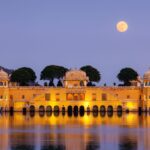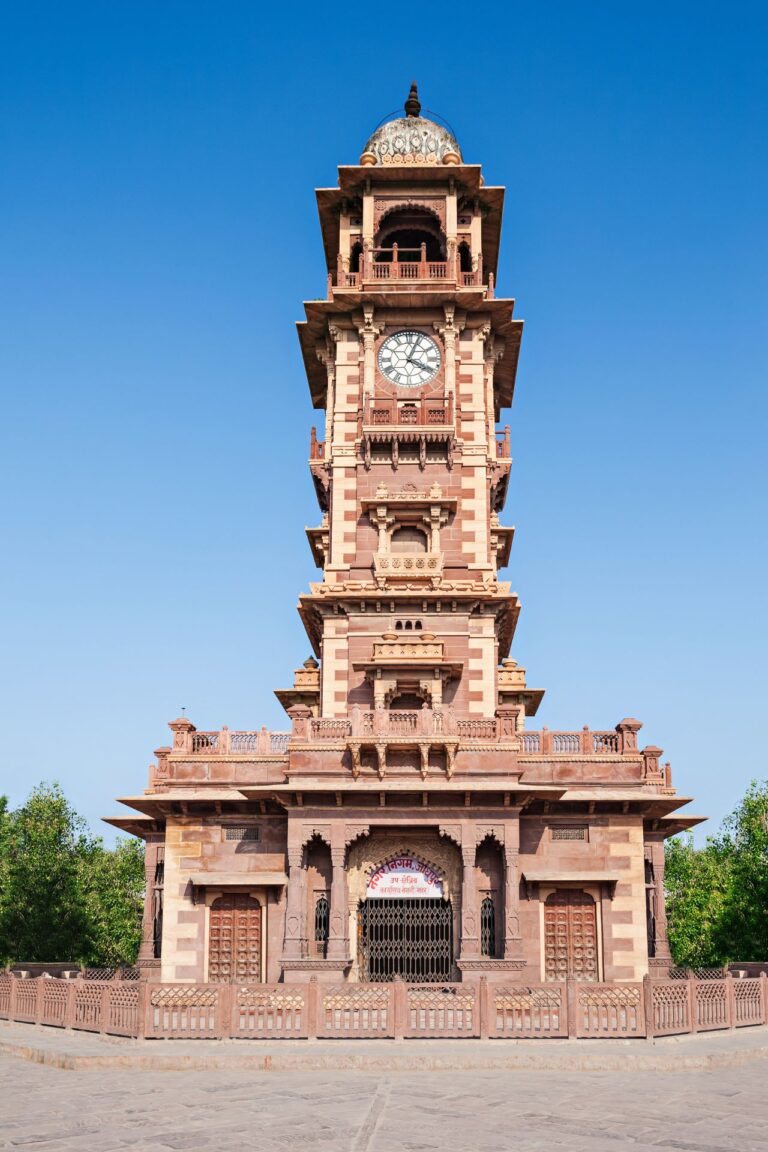Royal Rajasthan
13 Nights/14 Days
Delhi – Mandawa – Bikaner – Jaisalmer – Jodhpur – (via Ranakpur) Udaipur – (via Pushkar) Jaipur – (via Fatehpur Sikri) Agra – (via Sikandra) Delhi
Royal Rajasthan


Discover Rajasthan’s Royal Treasures
We will guide you through the regal romance of Rajasthan, its deserts, hues and music, small recluse hamlets and bewilderingly gigantic palaces, and delectable cuisine, all of which combine to form an unforgettable and colourful tapestry.

Itinerary
Hello and welcome to India! When you arrive at Delhi Airport, you will be greeted in the arrival hall by our guide, who will accompany you to your hotel and assist you with check-in. After that, go on a sightseeing tour of Delhi. Begin by touring Delhi’s Old City, where Mughal art and architecture can still be found in the small streets lined with havelis, mosques, and food stalls selling traditional Mughlai cuisine, a staple of Indian cuisine. The Red Fort, Jama Masjid, Chandni Chowk Raj Ghat, and Mahatma Gandhi’s cremation site are among the tourist attractions of Old Delhi. Visit Humayun’s Tomb, a UNESCO World Heritage Site and India’s first garden-tomb, which inspired the Taj Mahal. Overnight, stay at hotel.
After breakfast, drive to Mandawa, situated 250 km (approximately five hours) from Delhi. The city of Mandawa lies in the Shekhwati region of Rajasthan and dates back to 18th century. Mandawa is known as Rajasthan’s “Open Art Gallery” because of its spectacular havelis (mansions) with intricate frescoes and paintings. It has also appeared in a number of Bollywood films. When you arrive in Mandawa, check into your hotel and relax for a while. Later, explore your surroundings by strolling around the marketplaces, which are a mecca for art and painting enthusiasts. Tonight, for dinner, try Shekhawati dishes from Rajasthani cuisine, particularly kair – sangri ki subzi for the main course and ghevar for dessert. Overnight, stay at hotel.
Spend the morning exploring some of Mandawa’s famed havelis, which are known for their fresco murals. Jhunjhunwala Haveli, Murmuia Haveli, and Goenka Double Haveli are just a handful of the well-known havelis. Finish your morning excursion with visiting Thakur Ji Temple and Mandawa Fort. Later, drive 220 kilometres (about five hours) from Mandawa to Bikaner. Bikaner, founded in the 15th century by Rao Bika and the Jats, became famous around the world for its snacks and sweets. Rajasthan, a beautiful city in the Thar Desert, retains its old-world elegance and symbolises the chivalry, valour, and bravery of regal Rajputs. Cotton and wool items, embroidered mojri (slip on shoes). Overnight, stay at hotel.
After breakfast, begin your city tour at Junagarh Fort, which provides insight into the luxurious lifestyle of Rajasthan’s former Maharanas. Temples, palaces, and a museum are housed within the fort complex. Then, pay a visit to Laxmi Niwas Palace, the former royal residence of Bikaner’s Maharaja Ganga Singh. The palace building, designed in the Indo-Saracenic style, is a magnificent structure of red sandstone that merges nicely with its gorgeous surroundings. Later, discover the Karni Mata Temple, popularly called the “Temple of Rats”, home to 20,000 rats. Afterwards, drive to Jaisalmer, 330 km (approximately six hours) away. Jaisalmer is the heart and soul of the Great Indian Desert – Thar Desert, and is often referred to as the “Golden City” of India. On arrival in Jaisalmer, check-in at hotel. Overnight, stay at hotel.
Jaisalmer owes its title of the “Golden City of India” to the yellowish-golden tinge that is present in most of the city’s architecture. This colour comes from the yellow sand and the yellow sandstone used prominently in constructions. Jaisalmer is also famous for its hospitality and for having the warmest people in the country. The day is dedicated to discovering the living fort of Jaisalmer, where a quarter of the city’s population still resides. Raj Mahal (Royal Palace), Laxminath temple and Jain temples are the main areas to explore within the fort. Jaisalmer is also famous for its spectacular havelis, many of which you can visit. In the evening, enjoy a sun downer on the Sam Sand Dunes while watching a beautiful sunset. Dinner is also served on the dunes with live traditional music, songs and folk dance performance.Overnight, stay at hotel.
After a leisurely breakfast, drive to Jodhpur, which is 300 kilometres (about five hours) from Jaisalmer. Jodhpur, the princely city, is known as the Sun City because of its beautiful weather all year. It is also known as the “Blue City” since the majority of the houses are painted blue. Check into your accommodation upon arrival in Jodhpur. Later, visit the well-known Jodhpur markets of Tripola Bazaar, Sardar Market, and Clock Market. They are the most popular venues to buy famous tie-dye textiles (bandhani), mojri (footwear), and traditional Indian handicrafts. Like the other cities, Jodhpur is also very well known for its snacks and sweets. Taste some of its popular snacks such as pyaaz ki kachori, badaa, gathiya and sev, relish the traditional Indian ice-cream called malai kulfi, and don’t forget the world famous Motichur laddu. Overnight, stay at hotel.
.
Today you spend the day discovering the Blue City. Start at the mighty Mehrangarh Fort, one of the largest forts in India. The fort houses some of the finest palaces and its museum preserves many priceless relics exhibiting Indian chivalry life. Moti Mahal (Pearl Palace), Sheesha Mahal (Mirror Palace), Daulat Khana (Treasure), Armoury Gallery, Palanquins Gallery, Turban Gallery, Loha Pol (Gate) and Dedh Kemgra Pol (Gate) are the major attractions of the fort. Nestling on a rocky hill, the fort offers a breathtaking panorama of Jodhpur from its ramparts. Also, stop at the elegant Jaswant Thada, the cenotaphs of Maharaja Jaswant Singh II and other maharajas. The cenotaphs of the maharanis are at Mandore. In the afternoon, take a jeep drive through Bishnoi village. The locals are ardent ecologist and are responsible for preserving many endangered species liks the black buck antelope. Overnight, stay at hotel.
Drive 260 kilometres (around five hours) from Jodhpur to Udaipur this morning. Today’s journey takes you across the Aravali Hills, the world’s oldest mountain range. The scenery along the road is breathtaking, and you will see numerous scenes from Rajasthani country life. This morning, your first visit is at Ranakpur’s white marble temples. These lavishly and artistically carved temples belong to the Jain religion and are considered one of the area’s architectural treasures. The exquisite carvings stand in stark contrast to the religion’s emphasis on simplicity and austerity. Check into your hotel upon arrival in Udaipur. Relax this evening by taking a boat trip on Lake Pichola. Overnight, stay at hotel.
Embark on a sightseeing tour in and around Udaipur. The gleaming Lake Pichola, the fabulous palaces, havelis, temples and bustling markets with the majestic Aravalli Hillls in the backdrop, make Udaipur a royal romantic destination. Udaipur city tour starts with a visit to the City Palace. The royal abode of Maharanas of erstwhile, the palace displays an elaborate and flamboyant style which combines both the Rajasthani and Mughal architectural design. Strategically placed on a hill top, the palace gives an impressive view of Udaipur and its beautiful sites such as the Lake Pichola, the Jag Mandir, the Monsoon Palace and Neemach Mata Temple. In the evening visit Jagmandir Island, Ahar (Udaipur’s royal cremation ground), Shilpgram (a crafts village) and Sajjan Garh (Monsoon Palace). Overnight, stay at hotel.
Check out of the hotel early in the morning and drive to Jaipur, which is 430 kilometres (about six hours) from Udaipur. Jaipur, India’s first planned city, was founded in 1727 by Maharaja Jai Singh II. Jaipur is known as India’s “Pink City” since it was painted pink to mark the visit of the Prince of Wales in 1876. Many of its avenues stayed pink for a long time, giving the city a distinct image. En route, stop in Pushkar, an ancient city on the shores of Lake Puskar. It is known as the “Tirth Raj,” or “King of Hindu Pilgrimages,” since it is home to the famous Lord Brahma Temple, which is considered the most important of the Brahma Temples. Check into your accommodation upon arrival in Jaipur. Overnight, stay at hotel.
Start the day with an excursion to the Amer Fort. Perched on a hill in the suburbs of Jaipur, the fort was once the capital of Rajasthan. Former residence of Rajput Maharajas, the fort is notable for its grand architecture showcasing Hindu style of art. Later, explore the City Palace complex that is comprised of two palaces, Chandra Mahal and Mubarak Mahal, a museum, a vast array of courtyards, gardens and buildings. The palace is a blend of the Shilpa Shastra of Indian architecture with Rajput, Mughal and European styles. Diwan-I-Aam (Hall of Public Audience), Bhaggi Khana (a museum), Pitam Niwaa gate and Peacock Gate are a must-see. Other places to visit include Hawa Mahal (Palace of Wind), Jal Mahal (Water Palace), and Jantar Mantar (an observatory). Make sure to spend some time in the charming markets of the Old City. Overnight, stay at hotel.
Today, drive 240 kilometres (about five hours) to Agra, the home of the Taj Mahal, an image of eternal love. Visit Fatehpur Sikri on the way. It’s a UNESCO World Heritage Site that showcases the magnificence of Mughal architecture and is well worth the visit. When you arrive in Agra, check into your hotel and begin your city tour. Visit the beautiful Taj Mahal this evening, which poets have characterised as “a teardrop on the cheek of eternity.” Shah Jahan erected the monument as a tomb in honour of his favourite bride, Mumtaz Mahal. It was described as “the jewel of Muslim art in India and one of the universally admired masterpieces of the world’s heritage” when it was designated a UNESCO World Heritage Site in 1983. Millions of tourists visit the ivory-white marble monument surrounded by lovely gardens all year. Overnight, stay at hotel.
After breakfast, check-out from hotel and drive to Delhi, 240 km (approximately four hours) away. Before you leave the city, visit the mighty Agra Fort – a World UNESCO Heritage Site. En route, stop at Sikandra to visit the Tomb of Akbar the Great. The tomb of the great emperor is an architectural marvel showcasing the splendid Mughal architectural style. Construction of the tomb was commenced by Akbar himself and was completed after his death by his son, Jahangir. The four white marble minarets at entrance of the tomb from the South gate are similar to those of the Taj Mahal. On arrival in Delhi, check-in at hotel and the rest of the day is at leisure. Overnight, stay at hotel.
Your trip to India comes to an end today. We will arrange for your transfer to Delhi Airport, where you will take your journey back home. If necessary, our representative will assist you with a seamless check-out from the hotel and will accompany you to the airport. To avoid last-minute problems, we recommend arriving at the airport at least 3 hours before departure and keeping your passport and airline ticket printout accessible. This itinerary merely scratches the surface of India’s incredible diversity and beauty, and we hope you will return soon to discover more. Namaste!
